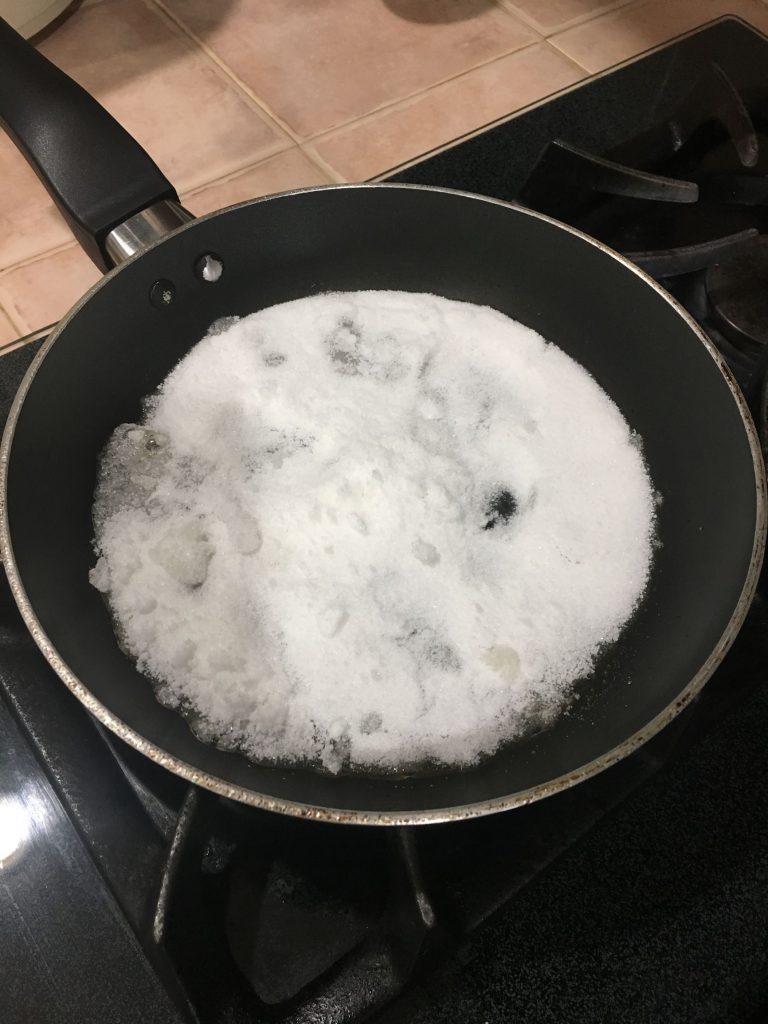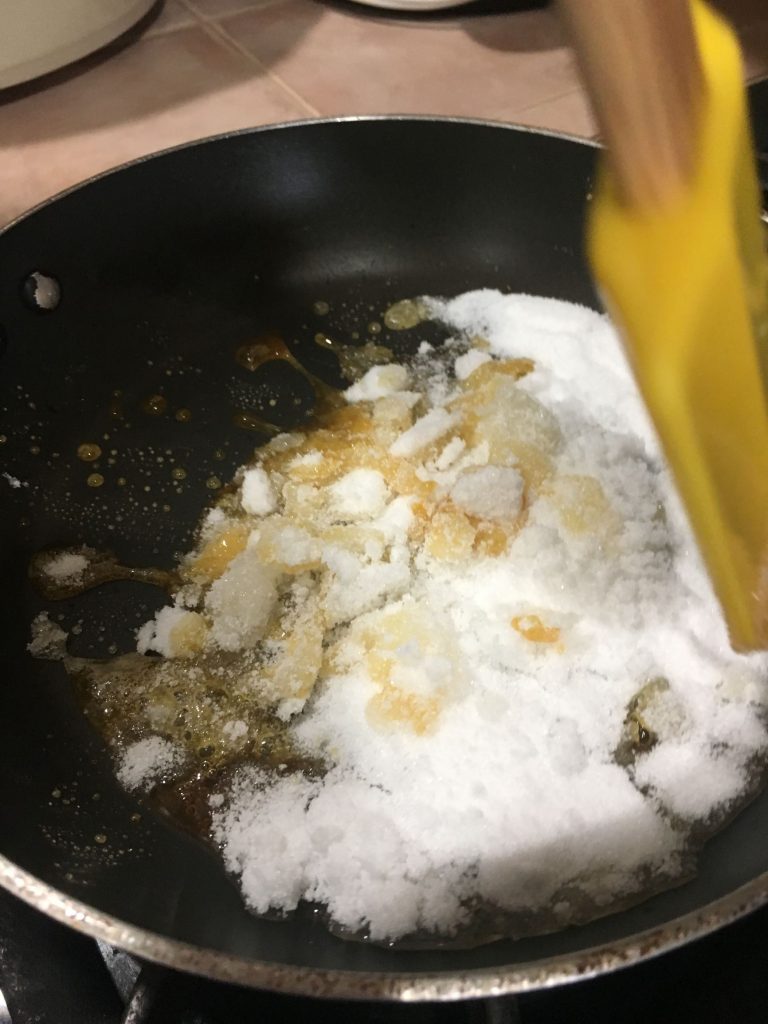Flan is an icon custard dessert from Spain with origins in Roman times. Almost every country has their version of this delicious custard. When Gail Borden, Jr. invented canned milk in the early 1850’s, he not only fed the military during the civil war, he revolutionized kitchens around the world and modernized this ancient dessert. Thank you Mr. Borden!
My great-grandmother emigrated from Asturias, Spain to Cuba. This is her flan and this recipe has been passed down in our family for generations. The basic custard recipe is the same for Flan (milk flan) or Flan de Queso (cheese flan). My personal favorite is the one with cheese, Flan de Queso. When something isn’t broken, you don’t fix it. This recipe is classic, timeless and turns out a perfect flan every time.
Making The Caramel Sauce
Place a small skillet on the stove and set the temperature to medium to high heat. Add about 1 cup of white granulated sugar. That’s it. No water needed. Let it sit over the heat until the edges start to get a golden color. With a temperature safe spatula, slowly and carefully move the sugar around – always away from you. Continue stirring until the caramel is a deep golden color. When the sugar has dissolved and the sauce has a glossy sheen, turn the burner off.
Coating The Mold:
Protect your hands by wearing oven mittens. The caramel sauce will quickly heat the mold and it’s as hot as molten lava! Yes, I’m exaggerating, but you get my point. Pour the caramel sauce into the mold and rotate the mold so the sauce coats the bottom and sides of the pan. Using a spatula is helpful when coating the sides. As the sugar cools it will be less fluid. Once the inside of the pan has been coated, you can set it aside and make the flan custard.
SAFETY NOTE: I can’t stress enough how intensely hot the sugar becomes and how severe and potentially permanent a sugar burn can be. Please protect yourself and be careful.
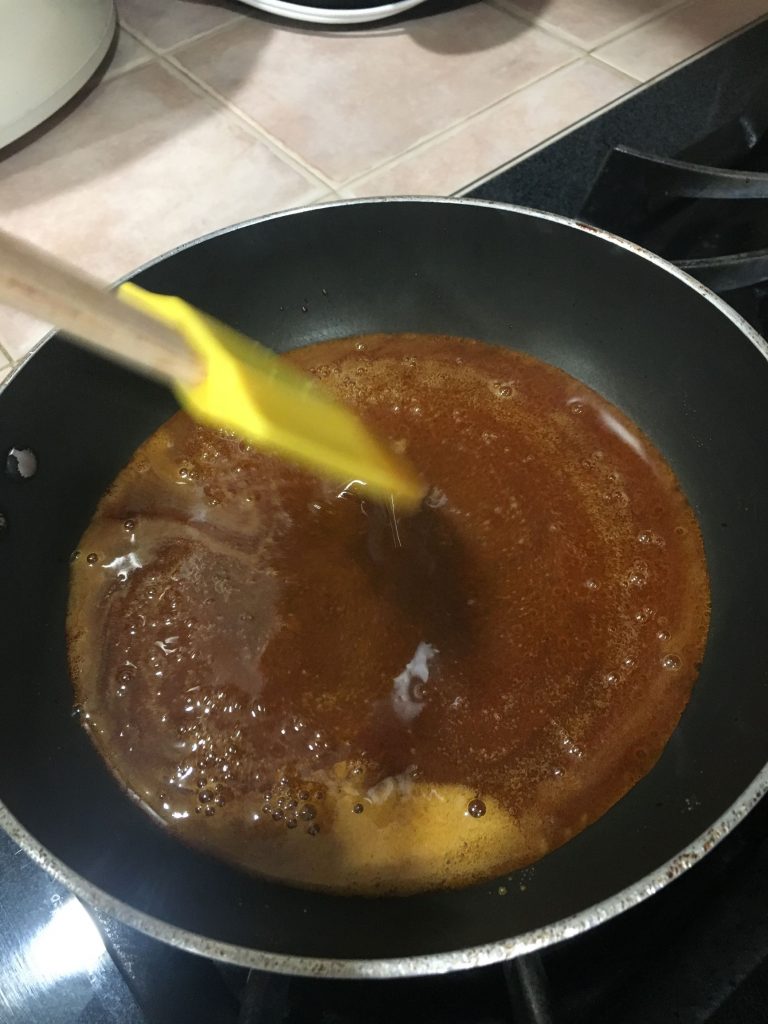
Caramel sauce almost done. 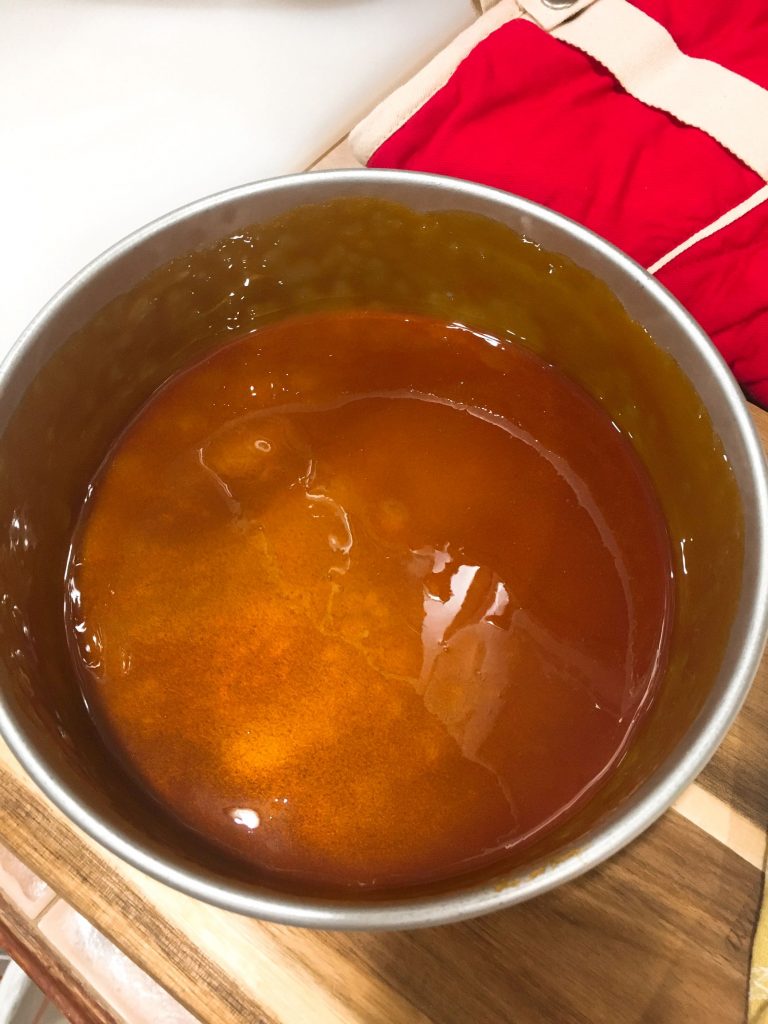
Glossy caramel sauce coating the mold.
Making The Flan:
Make sure your ingredients are at room temperature. Beat the cream cheese until it’s smooth in consistency. Add the egg yolks and whole eggs and mix to combine. Add the condensed and evaporated milks and pure vanilla extract. Mix well so all ingredients are well blended. Pour the mixture through a sieve into the mold you just coated with the caramel sauce.
Tip: I like my custards to be velvety without lumps, bumps or clumps so all my custard mixtures go through a sieve. It makes a world of difference in the finished product.
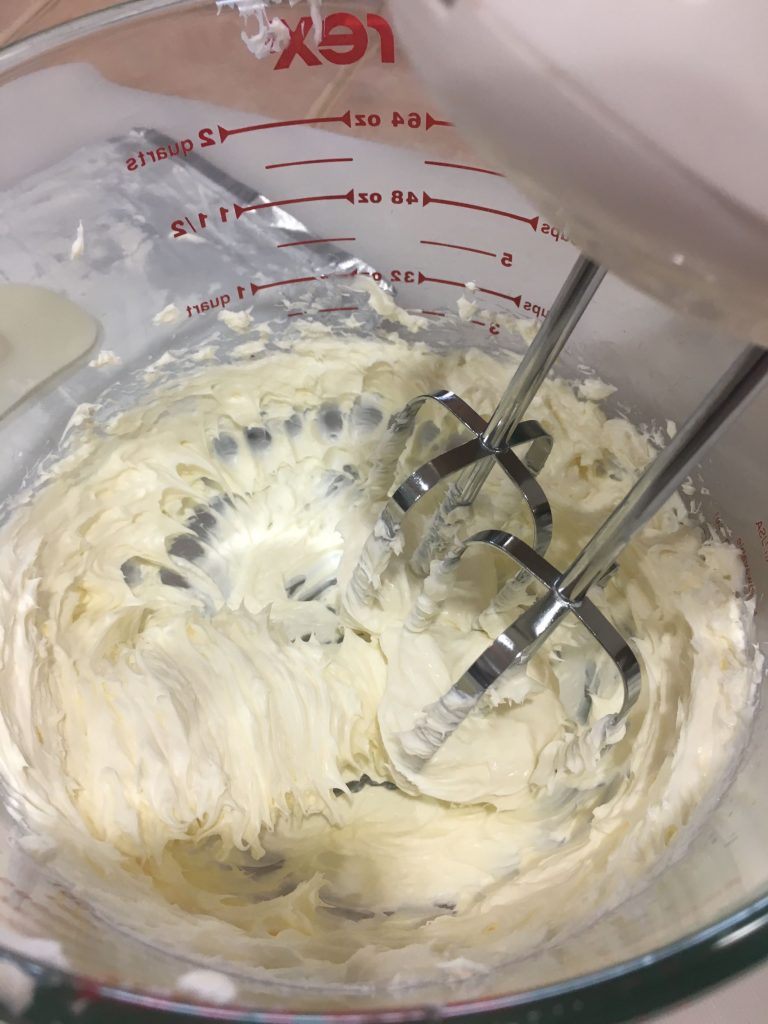
Beat the cream cheese until smooth. 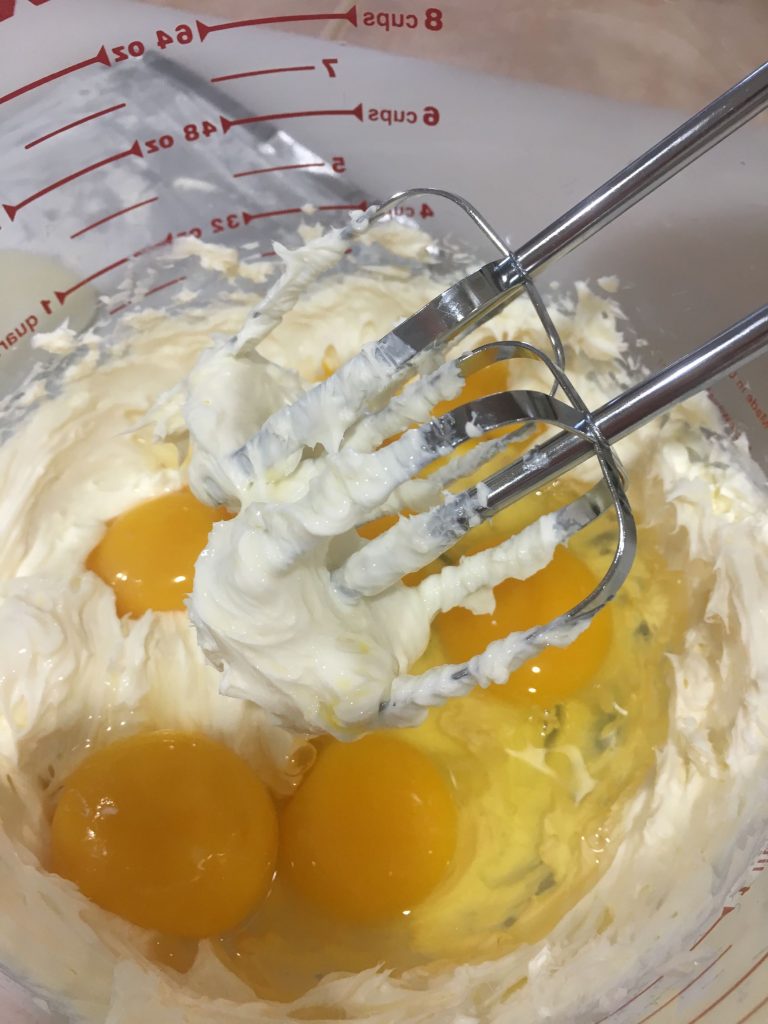
Add 3 eggs and 3 egg yolks, mix to combine.
Place the mold in a roasting pan and place the roasting pan in the center oven rack. Fill with boiling water halfway up the side of the flan. Bake at 350° for 50 – 60 minutes. My flan was done at 50 minutes. To test doneness, jiggle the flan mold. The top should be golden and jiggly, but intact. If the flan splits, it’s not done. Close the oven door and continue baking for 5 minutes before testing again. If your flan doesn’t split, it’s done. Remove the flan mold from the roasting pan/oven and place it on a baking wire rack, allowing it to cool for an hour. Then place in the refrigerator for 4 – 5 hours.
Note: Some bakers place a wet kitchen towel on the roasting pan and place the flan mold on top of the towel. I don’t do this step and my flan has never burned or cooked unevenly.
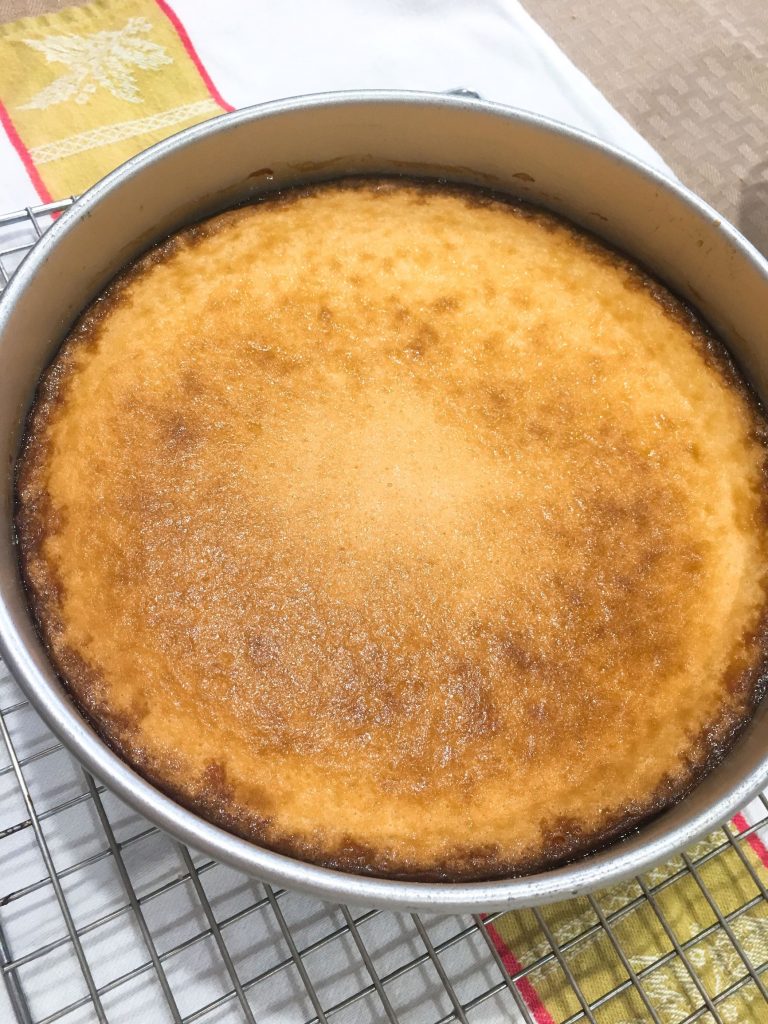
Flan de Queso cooling on the baking wire rack. 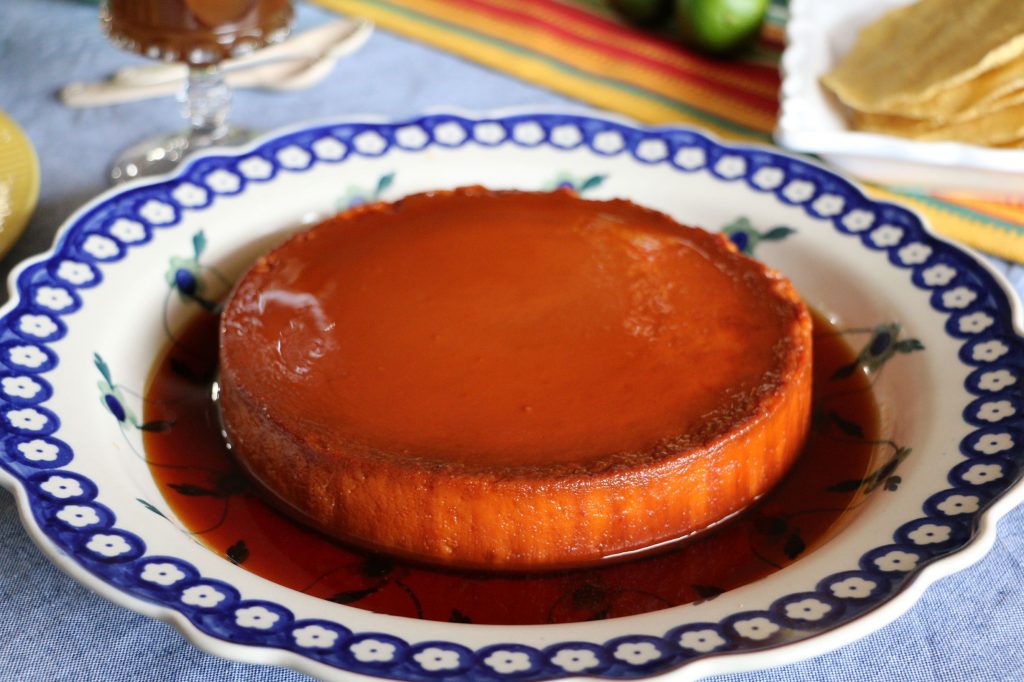
Inverting Your Flan:
The sauce has hardened somewhat and your flan may stick to the mold. You’ll need to apply a little heat to the flan so the sugar melts and the flan releases. If you take a closer look at my photo, there’s a jagged side to my flan, that’s because I omitted this step. Shame on me! I should know better.
You can either place the flan mold on a burner over low heat for 10-15 seconds or you can return it to a water bath in the roasting pan. The latter will take longer. Once the sauce is more liquid, the flan will pull away from the mold. If the sides are sticking, run a knife around the edges to release the sides.
Here’s the fun part, the flip! Place your serving dish over the flan. Tightly grasp both the mold and serving dish at the same time by the sides and quickly flip it over. Voila! The flan will drop onto the serving dish and the sauce will spread out.
Tip: Make sure your serving dish has a lip so the caramel sauce doesn’t roll off the plate. Done that!
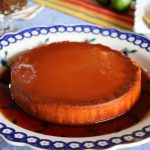
Cuban Flan de Queso
This is my great-grandmother’s recipe. My family has been making this flan for decades. It’s a smooth and creamy custard with a caramel syrup glaze. I hope you enjoy it as much as we do.
Ingredients
- Caramel glaze:
- 3/4 to 1 cup granulated sugar
- Flan de Queso:
- 1 8 ounce bar Philadelphia cream cheese, room temperature
- 3 eggs, room temperature
- 3 egg yolks, room temperature
- 1 14 ounce can sweetened condensed milk
- 1 12 ounce can evaporated milk (substitute whole milk)
- 2 teaspoons pure vanilla extract
Instructions
-
Equipment: skillet (not sauce pot), 8X3 round cake mold and roasting pan.
Preheat oven to 350°.
-
Add to a skillet over medium-high heat about 3/4 to 1 cup of granulated sugar. Don’t stir it, instead watch it until the edges start to turn a golden color. Using a temperature safe spatula, begin to move the sugar around in the pan – always away from you. As the sugar becomes caramel, it will develop that golden color. When all the granules have dissolved and you get a glass-like sheen, turn the heat off.
-
CAREFULLY, pour the hot caramel into your mold. Wear oven mittens to protect your hands. Rotate the pan so the sugar coats the pan. You can also use a spatula to gently move the sugar around and coat the bottom and sides evenly. As the caramel cools, it will harden. Once all the sides and bottom are evenly coated, set the mold aside.
-
In a separate bowl, using a hand-held mixer, cream the cream cheese. Add eggs and egg yolks and mix to combine. Add sweetened condensed milk, evaporated milk and vanilla. Mix well to combine all ingredients.
-
Pour the custard mixture through a sieve into the mold.
Note: The sieve will capture any cream cheese and egg particles that didn’t blend well. This step ensures no lumps or clumps in your flan. -
Place the custard in the roasting pan in the center oven rack. Fill the roasting pan with boiling water to reach halfway up the sides of the mold. This is a water bath or bain-marie.
Note: Some people place a wet dishcloth between the mold and the roasting pan.
-
Bake in the preheated oven for 50 minutes to an hour. Check for doneness. The center should jiggle, but not separate. If it splits, cook for 5 minutes and recheck.
-
Remove the flan from the oven and allow it to cool on a baking wire rack for one hour, then refrigerate for at least 4 hours. Leave the roasting pan in the oven and remove/discard water when it has cooled completely.
-
When you’re ready to serve, you need to loosen up the flan from mold. You need to apply a little warmth to release the bottom. Return the mold to the roasting pan and add boiling water to the roasting pan. As the sugar warms up again, it releases the flan from the mold. You can also run a knife around the inside to release the sides.
-
When the flan has loosened completely, place your serving dish over the flan. Grasp both tightly with your hands and quickly flip the flan onto the serving dish. The flan will drop onto the serving dish and the caramel sauce will spread out onto the serving dish. Serve immediately.


